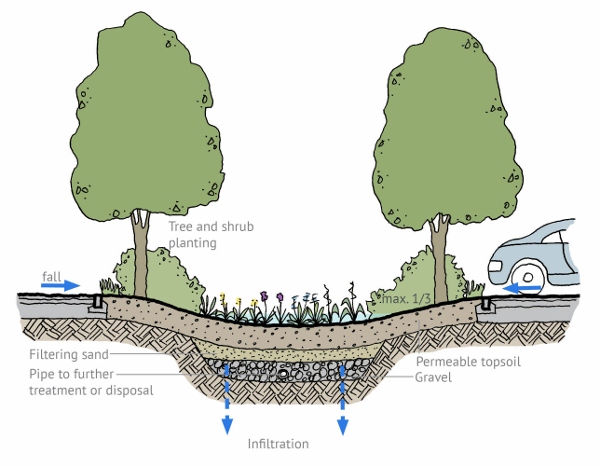- Delivering SuDS
- Using SuDS
- Background
- SuDS principles
- Benefits of SuDS
- Benefits of SuDS
- Why developers should choose SuDS
- Flood risk management
- Water quality management
- Biodiversity & ecology
- Amenity
- Air quality
- Building temperature
- Carbon reduction and sequestration
- Crime
- Economic growth
- Enabling development
- Flexible infrastructure/climate change adaptation
- Education
- Groundwater recharge
- Health and well being
- Pumping wastewater
- Rainwater harvesting
- Recreation
- Tourism
- Traffic calming
- Treating wastewater
- SuDS components
- SuDS components overview
- Source control
- Swales & conveyance channels
- Filtration
- Infiltration
- Retention & detention
- Wetlands
- Inlets, outlets and control structures
- SuDS performance & monitoring
- Delivery
- The costs & benefits of SuDS
- Adoption & maintenance of SuDS
- Legislation & regulation
- Design guidance
- Retrofitting SuDS
- Drainage exceedance
Filtration overview
Filtration and removing sediment or other particles from surface water runoff is one of the main treatment methods for sustainable drainage. This may occur through trapping within the soil or aggregate, on plants or on geotextile layers within the construction. The location of any filtration will depend upon the structure of the particular SuDS component. The components that are classified under filtration include:
Filter strips are gently sloping areas of grass that water flows onto and across, usually towards another component like a swale or filter drain. The main purpose of the filter strip is to remove any silt in the water so that it does not clog up downstream components. Filter trenches provide a similar function and are shallow excavations filled with gravel providing temporary subsurface storage for infiltration or filtration of runoff.
Bioretention areas (figure 1) are vegetated areas with specially designed engineering soils and sand layers, which filter out pollutants from surface water runoff normally associated with highways. Bioretention features have an aesthetic and biodiversity value as they can be planted to enhance local character and are attractive landscape features.
Bioretention areas are often depressions in the ground to create opportunities for storage and attenuation. The filtration layers are usually under drained using a perforated pipe system and where appropriate can allow infiltration. Trees can also be incorporated into bioretention systems and they can therefore be integrated with tree pits in streetscapes and other public realm areas.
Benefits
|
Filter strips |
Filter trench |
Bioretention area |
Read more on:




